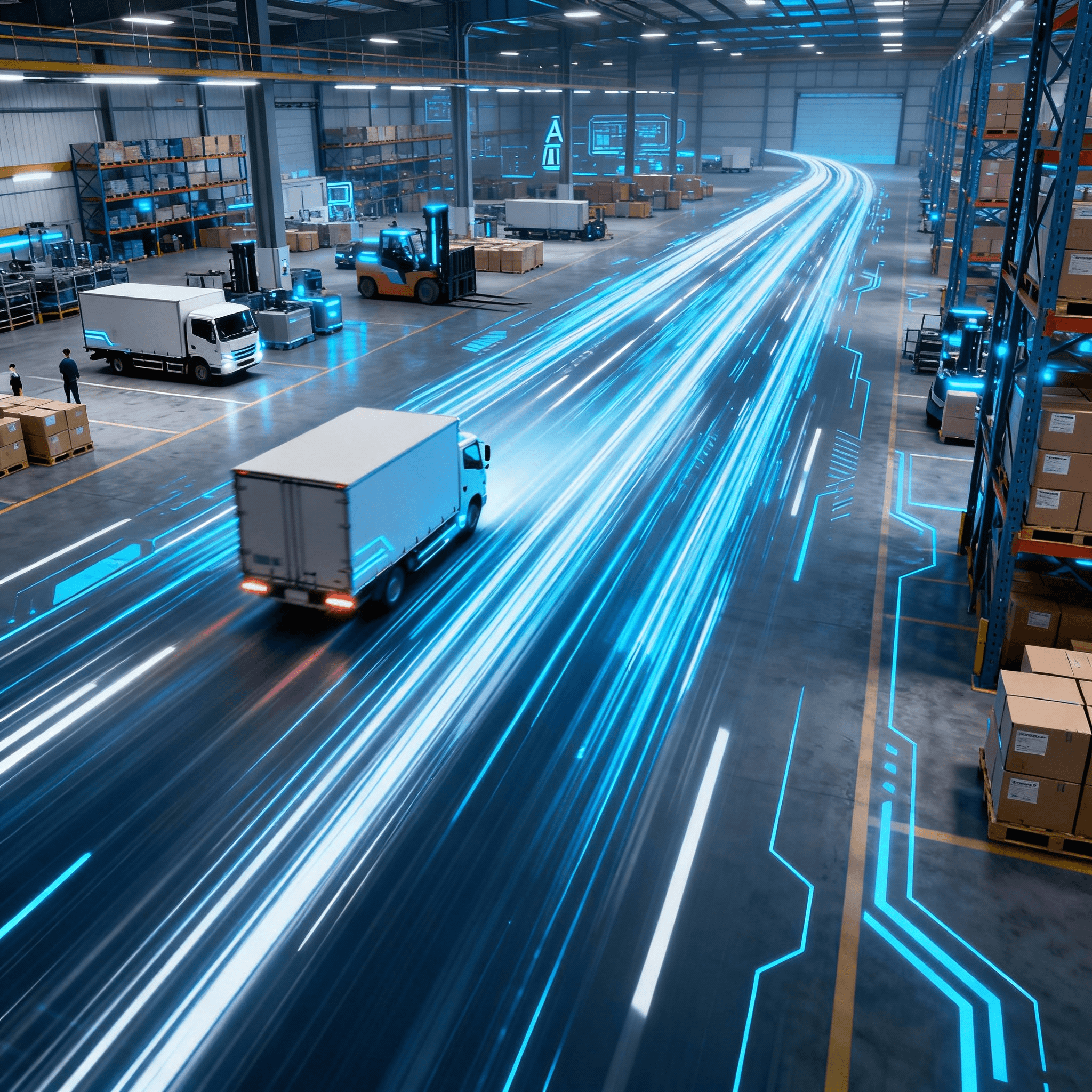How Does AI Improve Speed and Efficiency Throughout the Supply Chain?
Saturday, 4 Oct 2025
|
The supply chain is the backbone of any successful logistics operation, but traditional processes often face challenges such as inefficiency, high costs, and slow response times. As industries become increasingly competitive, businesses must find ways to optimize their operations, reduce operational costs, and enhance customer satisfaction. Enter Artificial Intelligence (AI)—the transformative force reshaping logistics.
AI is not just about automation; it's about using advanced algorithms and machine learning models to solve complex problems faster and more efficiently than ever before. Let's dive into how AI is improving speed and efficiency throughout the supply chain and why CEOs, CXOs, and COOs in logistics should be paying attention to its game-changing capabilities.
1. AI-Driven Demand Forecasting and Inventory Management
Why It Matters:
One of the biggest challenges for supply chain managers is predicting demand accurately. AI systems analyze vast amounts of historical sales data, market trends, and external factors (like weather or global events) to forecast demand with remarkable precision. This improves inventory management, reduces waste, and minimizes stockouts, all of which contribute to faster and more efficient supply chain operations.
How It Works:
AI models use historical data to make accurate demand predictions for various products, allowing businesses to optimize stock levels and reduce the amount of inventory that is tied up in unsold goods. This not only improves cash flow but also ensures that products are available when customers need them, accelerating delivery times.
Real-World Example:
Amazon is a prime example of how AI-driven demand forecasting works. Their sophisticated forecasting systems allow them to predict customer demand for products at a hyper-local level, optimizing their warehouses and supply chain operations in real time. This ability to forecast demand has helped Amazon reduce shipping times while minimizing the costs associated with overstocking or understocking.
2. Route Optimization for Faster Deliveries
Why It Matters:
Transportation is one of the most significant costs in the logistics sector. By improving delivery routes, businesses can drastically reduce fuel consumption, transportation time, and vehicle wear-and-tear—all of which contribute to operational efficiency. AI-powered route optimization tools use real-time data to suggest the most efficient routes for drivers.
How It Works:
AI models consider multiple variables, including traffic patterns, weather conditions, and road closures, to create optimal routes for shipments. This ensures faster deliveries, fewer delays, and a reduction in operational costs associated with transportation.
Real-World Example:
UPS’s ORION (On-Road Integrated Optimization and Navigation) system uses AI to optimize delivery routes for drivers. The system analyzes millions of possible route combinations and delivers optimal, time-efficient results. UPS reports saving millions of dollars annually by reducing the number of miles driven per delivery and improving fuel efficiency.
3. Automated Warehousing and Robotics for Faster Processing
Why It Matters:
Warehouse operations are often bottlenecks in the supply chain. Manual labor can slow down the sorting, packing, and shipping of products, especially during peak seasons. AI-driven automation tools and robots can streamline these processes, allowing for faster and more accurate handling of goods.
How It Works:
AI-powered robots can autonomously navigate warehouses, picking up and transporting items from one location to another. Additionally, AI systems can optimize warehouse layouts by analyzing product demand and traffic flow, ensuring that the most popular items are closest to the packing areas.
Real-World Example:
Alibaba uses AI-powered robots in their warehouses to speed up product sorting and packing. These robots not only increase speed but also reduce human error, ensuring that the right products are delivered to customers in record time.
4. Predictive Maintenance for Minimizing Downtime
Why It Matters:
In logistics, vehicle breakdowns or warehouse equipment failure can lead to costly delays and lost productivity. Predictive maintenance uses AI to predict when equipment will require maintenance, helping logistics companies avoid unexpected downtime.
How It Works:
AI algorithms analyze data from sensors embedded in vehicles and equipment to identify signs of wear or potential failure. By predicting these issues before they occur, businesses can schedule maintenance during off-peak hours, ensuring that operations continue smoothly without unnecessary interruptions.
Real-World Example:
DHL utilizes AI for predictive maintenance on their fleet of delivery vehicles. By predicting when a vehicle is likely to fail and scheduling maintenance ahead of time, DHL reduces the risk of breakdowns, keeping their operations running efficiently.
5. AI-Enhanced Supply Chain Visibility
Why It Matters:
Supply chain visibility is crucial for making informed decisions and responding to issues as they arise. AI enhances visibility by consolidating data from multiple sources (e.g., suppliers, warehouses, transportation, etc.) into a single platform. This allows businesses to track shipments, monitor inventory levels, and identify bottlenecks in real time.
How It Works:
AI systems integrate data from sensors, GPS devices, and real-time tracking tools to provide comprehensive, up-to-date information about the location and status of goods in transit. This enhances decision-making by providing logistics managers with the insights they need to address potential issues before they disrupt the supply chain.
Real-World Example:
Maersk, the global shipping giant, uses AI-powered platforms to offer customers real-time visibility into their shipments. With AI, Maersk can predict when a shipment will arrive and identify any delays caused by external factors, making it easier to manage customer expectations and improve service levels.
6. AI-Powered Supplier and Vendor Management
Why It Matters:
Effective supplier management is key to maintaining the speed and efficiency of the supply chain. AI tools can help businesses manage and evaluate suppliers based on performance metrics such as delivery times, quality, and cost, ensuring that the most efficient suppliers are prioritized.
How It Works:
AI systems analyze historical performance data and track key supplier metrics to identify trends and predict future performance. This helps companies maintain healthy supplier relationships and make informed decisions when selecting vendors.
Real-World Example:
Walmart leverages AI to analyze supplier performance, improving both its sourcing strategy and its ability to negotiate better terms. By optimizing supplier management with AI, Walmart can ensure that its supply chain operates smoothly and efficiently.
7. Real-Time Decision-Making with AI-Powered Analytics
Why It Matters:
In a fast-paced logistics environment, real-time decision-making is critical. AI provides executives and logistics managers with analytics that enable them to make data-driven decisions instantly, improving the responsiveness and agility of the supply chain.
How It Works:
AI-powered platforms collect and analyze data from across the supply chain, producing actionable insights that can be used to improve performance. This can include everything from adjusting inventory levels to re-routing shipments based on real-time data, ensuring that operations remain efficient and cost-effective.
Real-World Example:
C.H. Robinson uses AI to provide real-time analytics to its logistics managers, helping them make data-driven decisions that improve efficiency, reduce costs, and ensure timely deliveries.
Conclusion: Unlocking the Future of Logistics with AI
AI is revolutionizing every aspect of the logistics supply chain, from route optimization and inventory management to predictive maintenance and real-time decision-making. By leveraging AI’s capabilities, logistics companies can achieve unprecedented levels of speed, efficiency, and cost savings. As the logistics industry becomes more competitive, the businesses that embrace AI will be the ones to stay ahead of the curve.
Ready to Transform Your Supply Chain?
If you’re ready to see how AI can optimize your logistics operations and improve your bottom line, Book a Demo. Discover the power of AI and start making smarter, faster decisions today.
For more insights on how AI can improve supply chain operations, check out our blog posts on How Predictive Analytics Works for Logistics and AI-Powered Circular Supply Chains.
All blog posts
View All →
Friday, 28 Nov 2025
The 90-Day Roadmap: Moving from Ad-Hoc AI to Operational Excellence
Stuck in AI experimentation? Learn how to escape Level 2 maturity using the Mess-O-Meter to diagnose chaos, prioritize with triangulation, and scale in 90 days.

Thursday, 27 Nov 2025
Mess-O-Meter Deep Dive: Real Logistics Examples for Digital Maturity
Discover Mess-O-Meter examples diagnosing digital chaos in logistics—baseline workflows, benchmark maturity, create AI roadmaps with real steps for transformation success.

Wednesday, 26 Nov 2025
Multi-Agent AI via Email: End-to-End Automation for Logistics Complexity
Explore agentic orchestration where autonomous email AI agents coordinate freight, customs, insurance, and carriers—automating multi-party processes for resilient supply chains.